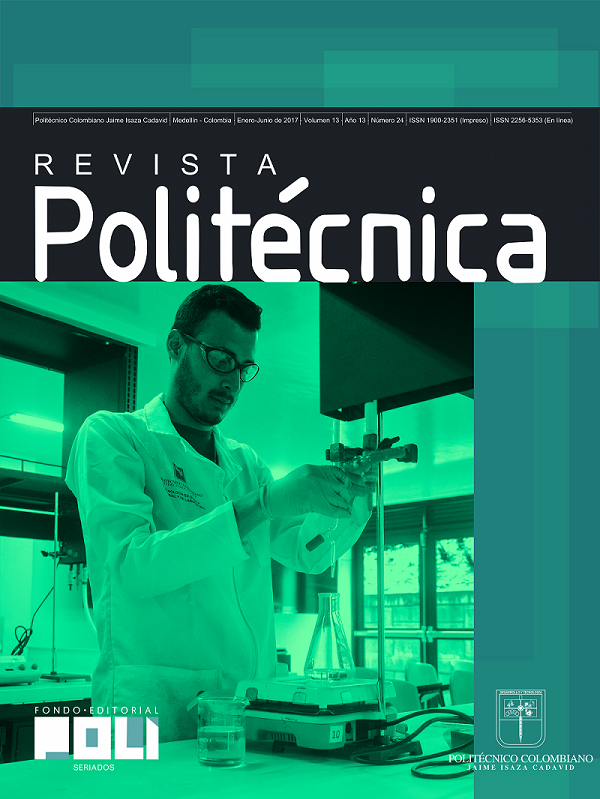Evaluación ambiental del proceso de elaboración de bolsas plásticas en Colombia utilizando la metodología de análisis de ciclo de vida
Keywords:
Life cycle assessment, carbon footprint, plastic carrier bags, indicatorAbstract
The research evaluated the production process of PP, PLA, cellulose and HDPE bags using the LCA tool. We used the international methodology published by ISO14040 and ISO14044, using impact assessment methods: CML2001, Eco-indicator 99 and ReCiPe. The analyzes were calculated using the Umberto software and the Ecoinvent 3.0 database. The production process of polypropylene bags has a carbon footprint of 1.99 kg CO2 eq, referred to 1.56 kg CO2 eq of the raw material, 0.19 kg CO2 eq of the transport, and 0.22 kg of CO2 eq of the extrusion. The process using the PLA as raw material has the lowest environmental loads (1.89X10-3 echo points Ecoindicator 99 and 0.22 ReCiPe method). The stages of extraction of crude and refining are the stages of process of greater impact. The production stage of raw materials has contributions higher than 90% for the processes of making polypropylene bag, high-density polyethylene and cellulose according to Eco indicator 99.Article Metrics
Abstract: 1896 HTML (Español (España)): 551 PDF (Español (España)): 5506 XML (Español (España)): 48References
Ayalon, O., Goldrath, T., Rosenthal, G. y Grossman, M. Reduction of plastic carrier bag use: An analysis of alternatives in Israel, Waste Management., 29, 2025-2032, 2009.
Yates, M.R. y Barlow, C.Y. Life cycle assessment of biodegradable, commercial biopolymers- A critical review, Resources, Conservation and Recycling., 78, 54-66, 2013.
RAO, K. The current state of biopolymer and their potential future. Disponible en: http://www.omnexus.com/resources/editorials.aspx?id2504 [Consultado el 04 de abril de 2017].
Khoo, H.H., Tan, R.B.H. y Chang, K.W.L. Environmental impacts of conventional plastic on bio-based carrier bags, Packaging Systems., 15, 284-93, 2010.
Rebistzer, G., Ekvall, T., Frischeknetcht, R., Hunkeler, D, Norris, G., Rydberg, T. y otros. Life cycle assessment. Part 1. Framework, goal and scope definition, inventory analysis, and applications, Environmental International., 30, 701-20, 2004.
Frischknecht, R. y Sutter, P. Öko-inventare von Energiesystemen, ETH-ESU, Oslo, 1996.
Harding, K.G., Dennis, J.S., Von Blottnitz, H. y Harrison, S.T.L. Environmental analysis of plastic production process: Comparing petroleum based polypropylene and polyethylene whit biologically-based poly-B-hyydroxybutyric acid using cycle analysis, Journal of Biotechnology., 130, 57-66, 2007.
ICONTEC. NTC-ISO 14040 Gestión ambiental. Análisis de ciclo de vida. Principios y marcos de referencia. Bogotá. ICONTEC, 2007.
ICONTEC. NTC-ISO 14044.Gestión ambiental. Análisis de ciclo de vida. Requisitos y directrices. Requisitos del ciclo de vida. Bogotá. ICONTEC, 2007.
CIRAIG. Ecoinvent 3.0. Ecoinvent database on Life cycle assessment. Zurich, 2013.
James, K. y T. Grant. LCA of Degradable Plastic Bags, Centre for Design at RMIT University, Melbourne, 2005.
Camargo, J.L., Arboleda, M.N., y Cardona, E. Producción de energía limpia en Colombia, la base para un crecimiento sostenible. Disponible en: http://www.xm.co/BoletinXM/Documents/MDLColombia_Feb2016.pdf (2013) [Consultado el 15 de febrero de 2017].
Plastic Europe. Eco-profiles of the European Plastic Industry-methodology. Disponible en: http://www.plasticseurope.org/plastics-sustainability-14017/eco-profiles/browse-by-flowchart.aspx?LCAID=r26 [Consultado el 02 de abril de 2017].
Muthu, S.S., Li, Y., Hu, J.Y. y Mork, P.Y. Carbon footprint of shopping (grocery) bags in China, Hong Kong and India, Atmospheric environment., 45, 469-475, 2011.
Asociación gremial de la industria del plástico de Chile (ASIPLA). Medición del impacto de gases de efecto invernadero en el ciclo de vida de los embalajes y otros productos plásticos en Chile V1.0. Disponible en: http://www.asipla.cl/wpcontent/uploads/2011/01/ASIPLA-frente-al-cambio-clim%C3%A1tico-Huella-de-Carbono.pdf [Consultado el 09 de mayo de 2017].


 _
_


















